
Two years ago I posted an
abstract from an article about the controversy surrounding a death mask identified as William Shakespeare. I recently received an email from University of Mainz academic Hildegard Hammerschmidt-Hummel, who is a champion of the mask, pointing out that she has written a book about the mask entitled "
The True Face of William Shakespeare. The Poet's Death Mask and Likenesses from Three Periods of His Life". In it, she explains the scientific methods she used to analyze the mask and compare it to four Shakespearean portraits.
She also includes information about how the portraits and mask point to the cause of Shakespeare's early death at 52 years old.
"By combining exhaustive academic research with the latest technology and collaborating over
many years with specialists from the most varied disciplines - including forensic experts from the German Federal Bureau of Criminal Investigation (BKA=CID), Professors of Medicine, 3D imaging engineers, archivists and an expert on old masters - Hildegard Hammerschmidt-Hummel has proved the authenticity of the Chandos portrait, the Darmstadt
death mask and the Flower portrait (recently incorrectly dismissed as a ‘fake’ by the National
Portrait Gallery, as shown by the author's latest evidence). Her revolutionary research has also
authenticated another true face of Shakespeare - the Davenant bust. This haunting sculpture has resided in the Garrick Club since 1855 and was thought to be the work of an eighteenth century sculptor. According to the author’s new documentary sources, it derives from the collection of Sir William Davenant (1606-1668), Shakespeare’s godson, who also owned the Chandos portrait.
By tracing the development of certain signs of illness in each of the images, first noticed by
Hildegard Hammerschmidt-Hummel, the author’s medical experts have identified and verified the most probable cause of Shakespeare’s death. The conspicuous growth on the upper left eyelid, they interpreted as Mikulicz Syndrome (a probably cancerous abnormality of the tear glands), the swelling in the nasal corner of the left eye as a fine caruncular tumour, and the considerable swelling on the forehead (in conjunction with the other pathological symptoms) as systemic sarcoidosis, an inner disease that affects the organs and takes a very protracted course, but proves to be fatal."
Professor Hammerschmidt-Hummel has also written a comprehensive biography of William Shakespeare that was released in October 2007.
"In this extraordinary study, Professor Hildegard Hammerschmidt-Hummel sets the great English playwright firmly in his time and reveals his deep involvement in the dramatic political events of the reigns of Elizabeth I and James I. After coming to the throne, Queen Elizabeth I made Anglicanism, a version of the Protestant faith, the official State religion. Catholicism was to be eradicated within her own lifetime. Brutal persecution of priests and believers in the Old
Religion followed, and they were forced to go underground or into exile. This background of
religious ferment meant that, due to their potentially explosive content, nearly half of
Shakepeare’s works could not be published during his lifetime, only becoming public seven
years after his death. Hammerschmidt-Hummel demonstrates how this turbulent religious and
political backdrop is the key to understanding so many of the secrets and puzzles of Shakespeare’s life and work.
Who were Shakespeare’s friends and enemies? What did he do during his ‘lost years’? How did
he manage to become the most influential writer in England in such a short time? What did his
contemporaries think and write about him? Why did he stop writing comedies, suddenly
producing mainly tragedies and problem plays? Is Hamlet, the tragedy of a great Prince in a
rotten State, a reflection of the dramatic and tragic events at the end of the Elizabethan age?
And why did Shakespeare fail to write one word of homage to the dead Queen after her 45-year
reign? Professor Hildegard Hammerschmidt-Hummel answers these and other key questions
in this comprehensive and groundbreaking biography of William Shakespeare. "
Professor Hammerschmidt-Hummel's website:
http://www.hammerschmidt-hummel.de
If you enjoyed this post, never miss out on future posts by following me by email!





